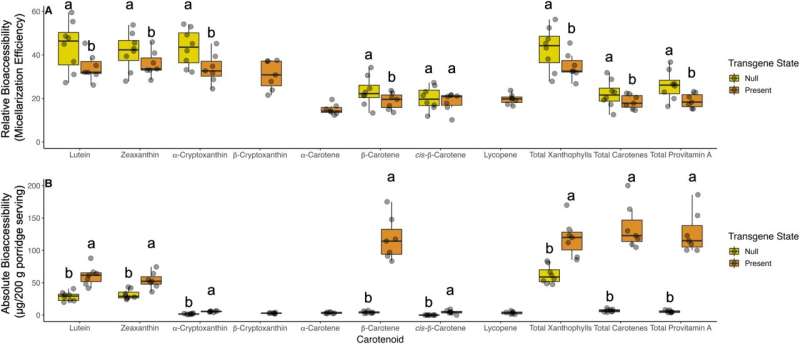This article has been reviewed according to Science X's editorial process and policies. Editors have highlighted the following attributes while ensuring the content's credibility:
fact-checked
trusted source
proofread
Scientists make healthy sorghum crop healthier

Scientists at the Children's Nutrition Research Center of the USDA's Agricultural Research Service (ARS) helped develop healthier sorghum varieties containing significant concentrations of provitamin A carotenoids while also increasing mineral absorption to meet the nutritional needs of mothers and children in sub-Saharan Africa.
The new varieties are the product of 20 years of collaborations from scientists with the USDA-ARS, the Arkansas Children's Nutrition Center (ACNC), North Carolina State University's (NCSU) Plants for Human Health Institute, and Corteva Agriscience.
Sorghum (Sorghum bicolor) provides many dietary benefits, as it is high in protein, fiber, B vitamins, and some micronutrients. But like many other cereal grains, it lacks sufficient vitamin A precursors and key minerals such as iron and zinc. Worse yet, it contains the natural antinutrient compound phytic acid, which prevents gastrointestinal absorption of minerals like iron and zinc. A significant issue, given that these micronutrients must be obtained from the diet.
"This research has important implications for people living in sub-Saharan Africa, where sorghum is a culturally significant staple crop and it's often eaten as a porridge, and is a primary source of dietary carbohydrates," says Michael Dzakovich, a researcher with USDA-ARS Children's Nutrition Research Center in Houston, Texas. "As a result, mothers and children in sub-Saharan Africa disproportionately suffer from chronic diseases related to insufficient vitamin A, iron, and zinc intake."
Vitamins and minerals are essential for immune system functions and disease prevention. According to the Centers for Disease Control and Prevention, children with Vitamin A deficiency face an increased risk of blindness and death from infections.
In the study, scientists developed advanced lines of sorghum enhanced with both provitamin A and non-provitamin A carotenoids using trait stacking, a biotechnological technique commonly used in plant breeding for integrating multiple traits at once in a plant. These varieties also contain a more efficient phytase enzyme (a protein that breaks down phytic acid).
Scientists wanted to evaluate how effectively carotenoids and minerals would be absorbed from the diet with these new varieties. They tested how different porridge preparations influenced the breakdown of phytic acid and increased the availability of minerals for absorption using a laboratory digestion model that mimics the human digestive system.
According to Dzakovich, the challenge is that increased levels of minerals in the gut, like iron and magnesium, have been linked to decreased carotenoid absorption. "There's a potential trade-off between carotenoids and minerals and we have to keep that in mind as we try to address vitamin A and mineral deficiencies at the same time."
Fortunately, the team found more positive results with the new varieties. "Our findings indicate that porridges made from the lines we developed are capable of delivering 32 times more provitamin A carotenoids than typical sorghum varieties while also providing minerals like zinc and iron. A child between the ages of four and eight may easily meet their daily vitamin A requirements with just a couple servings of porridge made from these biofortified lines," explains Dzakovich.
These sorghum lines also contained high concentrations of lutein and zeaxanthin, carotenoids which are important for eye health and brain development.
Future human trials will be needed to confirm that higher mineral bioavailability will not substantially affect the amount of provitamin A carotenoids that can be absorbed.
"I'm fortunate to have contributed to this project. It has enormous potential to impact food security, and I'm excited to see how these resources can be used to improve people's lives," says Dzakovich.
The study is published in the journal Food & Function.
More information: Michael P. Dzakovich et al, Trait stacking simultaneously enhances provitamin A carotenoid and mineral bioaccessibility in biofortified Sorghum bicolor, Food & Function (2023). DOI: 10.1039/D2FO03606A
Provided by United States Department of Agriculture




















